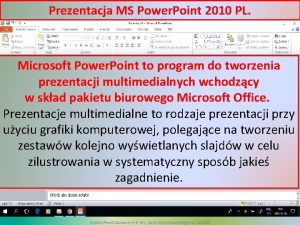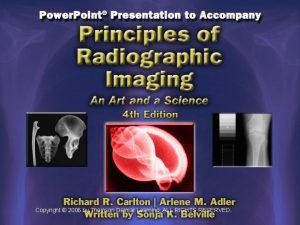Power Point Presentation to Accompany 2010 Delmar Cengage






























![Animation – Lymphatic System • [Insert Lymph. swf] © 2010 Delmar, Cengage Learning 31 Animation – Lymphatic System • [Insert Lymph. swf] © 2010 Delmar, Cengage Learning 31](https://slidetodoc.com/presentation_image_h2/8c269c6f3b0463486e4e7adbb3bd8b5e/image-31.jpg)

- Slides: 32

Power. Point Presentation to Accompany © 2010 Delmar, Cengage Learning

Chapter 15 The Lymphatic System © 2010 Delmar, Cengage Learning 2

Introduction • • Transports lymph through lymphatics Lymphatics: lymph capillaries and vessels Controls body fluid Destroys harmful microorganisms © 2010 Delmar, Cengage Learning 3

The Functions of the System and the Structure and Functions of the Lymphatic Vessels © 2010 Delmar, Cengage Learning 4

Introduction • Drain interstitial fluid from tissue spaces – Prevent edema • Transport digested fat to blood – Lacteals: special lymphatics in small intestine – Chyle: milky lymph in lacteals • Develop immunities • Produce lymphocytes © 2010 Delmar, Cengage Learning 5

Lymphatic Vessels • Lymph capillaries: blind-end tubes • Lymph capillaries are located between cells • Lymph capillaries unite to form lymphatics • Lymphatics converge into two main channels – Thoracic duct and right lymphatic duct © 2010 Delmar, Cengage Learning 6

Lymph Nodes • Found along lengths of lymphatics • Efferent: exit lymph node at the hilum • Afferent: enter lymph node at various locations • Trabeculae: divide the node into compartments • Germinal centers of compartments produce lymphocytes © 2010 Delmar, Cengage Learning 7

Lymph Circulation © 2010 Delmar, Cengage Learning 8

Lymph Circulation (cont’d. ) • Interstitial fluid: plasma in interstitial spaces • Lymph: interstitial fluid in lymph capillaries – Passes into lymphatics • Lymphatics join to form lymph trunks © 2010 Delmar, Cengage Learning 9

Lymph Circulation (cont’d. ) • Lymph circulation maintained by: – Normal skeletal muscle contractions • Compresses lymph vessels and forces lymph in one direction – Respiratory or breathing movements – Smooth muscle in lymphatic vessels © 2010 Delmar, Cengage Learning 10

Lymph Circulation (cont’d. ) • Lymph trunks – Lumbar: drains lower extremities and pelvis – Intestinal: drains abdominal region – Bronchomediastinal and intercostal: drain thorax – Subclavian: drains upper extremities – Jugular: drains head and neck © 2010 Delmar, Cengage Learning 11

Lymph Circulation (cont’d. ) • Individual trunks drain into two main trunks – Thoracic duct: drains into the left subclavian vein – Right lymphatic duct: drains into the right subclavian vein © 2010 Delmar, Cengage Learning 12

The Organs of the Lymphatic System © 2010 Delmar, Cengage Learning 13

The Organs of the Lymphatic System (cont’d. ) • Tonsils – Palatine, pharyngeal and lingual – Protect the nose and oral cavity • Thymus: lymphocyte production and maturation • Peyer’s patches: found in walls of small intestine © 2010 Delmar, Cengage Learning 14

The Organs of the Lymphatic System (cont’d. ) • Spleen – Largest mass of lymphatic tissue – Phagocytizes worn-out RBCs and platelets • Recycles hemoglobin – Produces lymphocytes and plasma cells – Stores blood for release during hemorrhage © 2010 Delmar, Cengage Learning 15

The Organs of the Lymphatic System (cont’d. ) • External view of the Spleen © 2010 Delmar, Cengage Learning 16

Immunity © 2010 Delmar, Cengage Learning 17

Immunity (cont’d. ) • Ability of body to resist – Infection from pathogens – Damage from foreign substances and harmful chemicals • Humoral immunity – B lymphocytes: produce antibodies • Fight circulating bacteria and viral infections • Become plasma cells when they enter tissues © 2010 Delmar, Cengage Learning 18

Immunity (cont’d. ) • Cellular immunity – T lymphocytes • Come from thymus glands • Fight intracellular viruses, fungi, parasites, cancer © 2010 Delmar, Cengage Learning 19

Antigens and Antibodies © 2010 Delmar, Cengage Learning 20

Antigens and Antibodies (cont’d. ) • Antigen: foreign protein in our body • B lymphocytes – Produce antibodies in response to antigens – Antibodies bind to specific antigen – Antigens precipitate – Phagocytic WBCs eat the antigens © 2010 Delmar, Cengage Learning 21

Antigens and Antibodies (cont’d. ) • Antibody morphology – Four amino acid chains linked by disulfide bonds • Heavy and light chains – Y shaped molecule – Binding sites at tips of Y – Stem of the Y is always constant © 2010 Delmar, Cengage Learning 22

Antigens and Antibodies (cont’d. ) • Antibody types – Ig. G: attacks viruses, bacteria, and toxins; activates complement – Ig. A: found in exocrine gland secretions – Ig. M: response to bacteria or food antigens – Ig. D: found on surface of B lymphocytes – Ig. E: associated with allergic reactions © 2010 Delmar, Cengage Learning 23

Antigens and Antibodies (cont’d. ) • Active immunity: B cells contact antigen and produce antibodies – Natural active: exposure to infection – Artificial active: vaccine • Passive immunity – Natural passive: maternal antibodies to fetus – Artificial passive: gamma globulin © 2010 Delmar, Cengage Learning 24

Cells of the Immune Response and Other Defenses © 2010 Delmar, Cengage Learning 25

Cells of the Immune Response and Other Defenses (cont’d. ) • B cells: antigen – Antibody binding • Plasma cells: replicated B cells • Helper T cells: stimulate production of – Killer T cells – More B cells © 2010 Delmar, Cengage Learning 26

Cells of the Immune Response and Other Defenses (cont’d. ) • Killer T cells: – Attack virus-invaded body cells – Attack cancer cells – Reject body grafts • Memory cells: descendents of activated T and B cells • Suppressor T cells: slow down activities of B and T cells © 2010 Delmar, Cengage Learning 27

Cells of the Immune Response and Other Defenses (cont’d. ) • Macrophages – Engulf and digest antigen – Present then to T cell for recognition © 2010 Delmar, Cengage Learning 28

Cells of the Immune Response and Other Defenses (cont’d. ) • Lymphokines: chemicals released by sensitized T cells • Monokines: chemicals released by activated macrophages • Skin: mechanical barrier – Acid mantle, sebum • Lysozyme: (tears and saliva) attacks bacteria © 2010 Delmar, Cengage Learning 29

Cells of the Immune Response and Other Defenses (cont’d. ) • Mucous membranes: trap microorganisms and debris • Hydrochloric acid: (stomach) destroys microorganisms © 2010 Delmar, Cengage Learning 30
![Animation Lymphatic System Insert Lymph swf 2010 Delmar Cengage Learning 31 Animation – Lymphatic System • [Insert Lymph. swf] © 2010 Delmar, Cengage Learning 31](https://slidetodoc.com/presentation_image_h2/8c269c6f3b0463486e4e7adbb3bd8b5e/image-31.jpg)
Animation – Lymphatic System • [Insert Lymph. swf] © 2010 Delmar, Cengage Learning 31

Summary • Discussed the functions of the immune system • Described lymph and its flow through the body • Discussed the functions of the spleen and tonsils • Described the different types of immunity • Discussed the immune response © 2010 Delmar, Cengage Learning 32
 Delmar cengage learning medical terminology
Delmar cengage learning medical terminology 2009 delmar cengage learning
2009 delmar cengage learning 2009 delmar cengage learning
2009 delmar cengage learning Graphing tpr
Graphing tpr 2009 delmar cengage learning
2009 delmar cengage learning Chapter 13 medical math assignment sheet cengage learning
Chapter 13 medical math assignment sheet cengage learning Chapter 10 cultural diversity
Chapter 10 cultural diversity Delmar cengage learning instructor resources
Delmar cengage learning instructor resources 2010 cengage learning
2010 cengage learning Hebrews 6:9-12 sermon
Hebrews 6:9-12 sermon Accompany chapter 1
Accompany chapter 1 Venous drainage of hand
Venous drainage of hand Printers create objects such as prototypes and models.
Printers create objects such as prototypes and models. Microsoft power point 2010
Microsoft power point 2010 Subject and topic in hindi
Subject and topic in hindi Power point presentation design west vancouver
Power point presentation design west vancouver Delmar isotonic
Delmar isotonic Delmar tsi
Delmar tsi Delmar custom broker
Delmar custom broker Delmar thomson learning
Delmar thomson learning Delmar larsen
Delmar larsen Power traiangle
Power traiangle Powerbi in powerpoint
Powerbi in powerpoint Point point power
Point point power Chapter 7:10 respiratory system
Chapter 7:10 respiratory system Cengage differential equations
Cengage differential equations Bank reconciliation cengage
Bank reconciliation cengage Cengage differential equations
Cengage differential equations Cengage chapter 7
Cengage chapter 7 Medical terminology chapter 5 learning exercises answers
Medical terminology chapter 5 learning exercises answers Cengage learning heart diagram
Cengage learning heart diagram Cengage
Cengage Cengage
Cengage























































